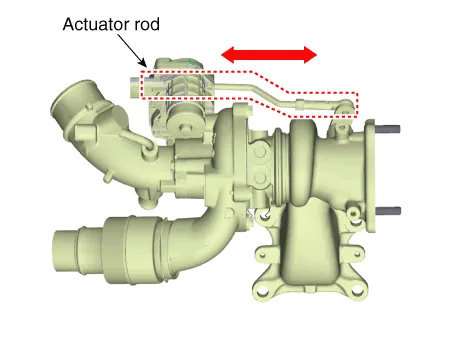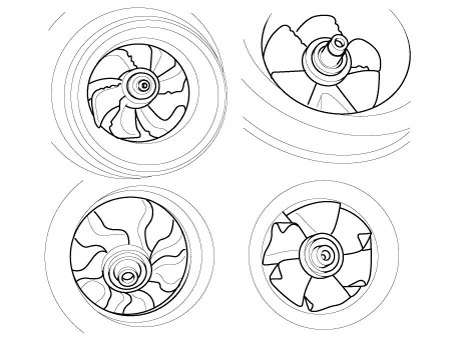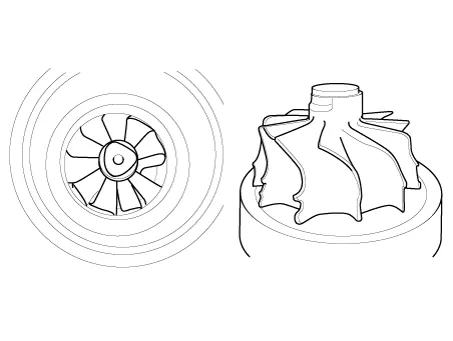Hyundai Elantra (CN7): Intake And Exhaust System / Turbo Charger
Repair procedures
| Removal and Installation |
| 1. | Remove the Turbocharger & Exhaust Manifold. (Intake And Exhaust System - "Exhaust Manifold") |
| On-vehicle Inspection |
| Turbocharger Diagnostic Flow |

| 1. | Check the assembly of the turbocharger and the exhaust fitting (or the after treatment).
Gas leakage caused by lack of gasket or inadequately tightened mounting bolts (or nuts) may cause abnormal engine noise. If the cause of the problem is detected, retighten the mounting bolts (or nuts) to the specified torque or replace the gasket or damaged parts with new ones if necessary. |
| 2. | Check the assembly of the exhaust manifold and the cylinder head.
Gas leakage caused by lack of gasket or inadequately tightened mounting bolts (or nuts) may cause abnormal engine noise. If the cause of the problem is detected, retighten the mounting bolts (or nuts) to the specified torque or install a new gasket if necessary. |
| 3. | Check the turbocharger oil feed pipe & hose and oil drain pipe & hose.
If a gas leak occur as a gasket was not installed or mounting bolts were tightened inadequately, it may cause oil leaks. If the oil feed pipe & hose is damaged, engine oil is not supplied sufficiently to the turbocharger then it may damage the turbocharger. If the oil drain pipe & hose is damaged and clogged, engine oil is not drained smoothly then it may cause oil leaks from the turbocharger. If the cause of the problem is detected, retighten the mounting bolts (or nuts) to the specified torque or replace the gasket or damaged parts with new ones if necessary. |
| 4. | Check for oil leakage between center housing and compressor housing.
Damaged O-ring (gasket) between the center housing and the compressor housing may cause oil leakage. If an oil leak is detected, replace the turbocharger with a new one. |
| 5. | Inspect the rod unit of the electric waste gate actuator (EWGA).
Damaged turbocharger actuator may cause lack of engine power and poor acceleration. If the actuator rod does not move, replace the turbocharger with a new one. |
| 6. | Check the electric waste gate actuator (EWGA).
|
| 7. | Check the turbocharger compressor wheel.
Damaged compressor wheel may cause abnormal noise from the turbocharger and poor acceleration. If the compressor wheel are damaged or deformed, replace the turbocharger with a new one. |
| 8. | Check the turbocharger turbine wheel.
Damaged turbine wheel may cause abnormal noise from the turbocharger and poor acceleration. If the turbine wheel are damaged or deformed, replace the turbocharger with a new one. |
| 9. | Check the blow-by hose. (Refer to FL group)
If the breather hose is bent or clogged, the internal pressure in the engine will increase and engine oil will not be supplied smoothly to the turbocharger, causing damage to the turbocharger and oil leakage. If the cause of the problem is detected, replace the breather hose or the related parts with new ones. |
| 10. | Check the air intake hose connected to the turbocharger.
If the cross-section of the hose diminishes as the air intake hose is bent or crushed, intake air to the turbocharger will be reduced and the pressure in front of turbocharger will drop, causing damage to the turbocharger or oil leakage. If the air intake hose is detached or torn, foreign substances may go into the turbocharger causing damage to it. If the air intake hose is damaged, replace it with a new one. |
| 11. | Check the air cleaner.
If the air cleaner filter is moistened or polluted excessively or a non-genuine part is used, intake air to the turbocharger will be reduced and the pressure in front of turbocharger will drop, causing damage to the turbocharger and oil leakage. If the air cleaner filter is moistened or polluted excessively, replace it with a new one.
|
| 12. | Check the intercooler hoses & pipes.
If the intercooler hoses & pipes are damaged or disconnected, oil leakage may occur from the hoses & pipes and the turbocharger may exceed the permissible speed causing damage to the turbocharger. If the intercooler hoses & pipes are damaged, replace them with new ones.
|
| 13. | Check the intercooler.
If the intercooler is damaged, the turbocharger may exceed the permissible speed causing damage to the turbocharger. If the intercooler is damaged, replace them with a new one.
|
| 14. | Check the engine oil.
If the engine oil level is low, amount of engine oil fed to turbocharger will be reduced causing the bearings in the turbocharger to adhere due to insufficient lubrication and cooling. If the cause of the problem is detected, add or change engine oil.
|
| 15. | Check the engine oil pressure.
If the engine oil level is low, amount of engine oil fed to turbocharger will be reduced causing the bearings in the turbocharger to adhere due to insufficient lubrication and cooling. If the cause of the problem is detected, add or change engine oil. If foreign substances are accumulated on the oil screen, wash the oil screen and replace the injector’s washer with a new one after checking the injectors for gas leaks. Check the engine oil-related parts, such as oil pump, if necessary.
|
| 16. | Check the injectors, sensors, etc. (Refer to Engine Control / Fuel System)
Improper operation of the injectors, sensors, EGR valve, etc. may cause diminished engine power. If the cause of the problem is detected, replace the related parts with new ones. |
Components and components location Components1. Oil drain pipe gasket2. Oil drain pipe3. Oil feed pipe4. Torbo charhe water outlet hose & pipe B5.
Repair procedures Removal and Installation1.Disconnect the battery negative terminal.2.Remove the engine room under cover.(Refer to Engine and Transaxle Assembly - "Engine Room Under Cover")3.
Other information:
Hyundai Elantra (CN7) 2021-2025 Service Manual: Troubleshooting
TroubleshootingWireless Power Charger System Troubleshooting Trouble status Inspection item Inspection Not chargedCheck the mobile phone status R-1Amber LED blinks OvercurrentR-2OverheatingR-2Foreign matterR-2R-1.
Hyundai Elantra (CN7) 2021-2025 Service Manual: Photo Sensor
Description and operation Description 1.The photo sensor is located at the center of the defrost nozzles.2.The photo sensor contains a photovoltaic (sensitive to sunlight) diode. The solar radiation received by its light receiving portion, generates an electromotive force in proportion to the amount of radiation received which is transferred to
Categories
- Manuals Home
- Hyundai Elantra Owners Manual
- Hyundai Elantra Service Manual
- Tire Specification and Pressure Label, Engine Number
- Interior Overview
- Driver assistance system
- New on site
- Most important about car





